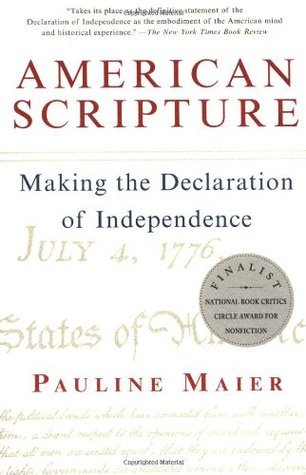What do you think?
Rate this book


336 pages, Paperback
First published May 26, 1997
In American Scripture: Making the Declaration of Independence, Pauline Maier sketches a history of the Declaration of Independence from its drafting in 1776 to reinterpretations of the document in mid-nineteenth century politics. Given the reverence for the Declaration in contemporary America, Maier seeks to explain the original intention of the document and how it became a national symbol. She argues that the Declaration emerged as a byproduct of the more critical decision by the Second Continental Congress to break from Great Britain and that its importance as a symbol for national self-definition emerged from the political battles of the early American republic.
Prior histories of the Declaration of Independence treat the document as a philosophical work produced by the individual brilliance of Thomas Jefferson and the general milieu of the Enlightenment. Maier presents the Declaration as an event and consummation of political struggle shaped by hundreds rather than by an individual. The Declaration is not the work of a single great man but rather an expression of the values of the American people. The Declaration of Independence emerges from a long-standing English constitutional tradition and particular sentiments already being expressed by Americans elsewhere. Pauline Maier presents a history of the Declaration of Independence as an expression of the American national character rather than the brilliance of any one man.
The text begins in ‚ÄúIntroduction: Gathering at the Shrine‚Ä� with a few anecdotes concerning the contemporary veneration of the Declaration of Independence by the United States. After considering the strangeness of the document‚Äôs current quasi-religious status, Pauline Maier states her intentions for writing a book on the Declaration of Independence due to her finding other histories lacking. Chapter One, ‚ÄúIndependence,‚Ä� charts how the Second Continental Congress moved from a position of reconciliation with Great Britain to the decision to break with the crown. Chapter Two, ‚ÄúThe ‚ÄòOther‚Ä� Declarations of Independence,‚Ä� considers the famous Declaration in the context of hundreds of local state declarations of rights and independence that pulled from a longer English constitutional tradition. Chapter Three, ‚ÄúMr. Jefferson and His Editors,‚Ä� details the drafting of the Declaration of Independence by Thomas Jefferson and his fellow committee members John Adams and Benjamin Franklin, and the following substantial changes made to the final draft by Congress. Chapter Four, ‚ÄúAmerican Scripture,‚Ä� follows the post-Independence history of the Declaration from a forgotten legal document to a shibboleth by which each American generation defines itself through the partisan political struggles of antebellum America. Finally, the Epilogue, ‚ÄúReflecting at the Memorials,‚Ä� returns to modern America to reflect on how Americans define themselves today regarding the Declaration of Independence.
The book contains a solid scholarly apparatus with three appendixes, a section of endnotes, and an index. The appendixes contain a log of state and local declarations of independence, some examples of local resolutions on independence, and Thomas Jefferson‚Äôs Declaration draft with Congress‚Äôs editorial decisions. Pauline Maier makes an admirable attempt to deflate the document‚Äôs overestimation by historians and laypeople. Her arguments connecting Jefferson‚Äôs Declaration to prior English legal documents and local American documents shatter the document‚Äôs exceptionalism. Maier‚Äôs attempts to ground the Declaration from its lofty heights ultimately fail due to her intellectual inheritance to a Whig historiography preventing any sobering confrontation with American nationalism. American Scripture elides the thorny contradictions of social and political history with a triumphalist narrative of liberalizing progress. Her argument that the ideas contained within the Declaration of Independence are an expression of popular American sentiments flattens the differences in ideology, class, region, and race between Americans. Her evidence for the popular support for independence consists of local and state support by various political assemblies. The political assemblies of colonial and early republican America were hardly democratic and often excluded men without property. There were divisions among the propertied classes between the northern proto-bourgeois, the western petty-proprietors, and the southern slavocracy. Despite a proposed unity, loyalist Tories remained within the colonies. The Whig school of history only considers the American people as an abstract national collective rather than concrete historical individuals. The chapter, ‚ÄúAmerican Scripture,‚Ä� suffers from the worst of the Whiggish optimism as Maier completes her narrative with the triumphant inversion of the Declaration written by slave-owners into a rallying call for emancipation. She conveniently ends her narrative before the complications of postbellum and America and completely ignores the Cold War. During this period of American history, moral ambiguities creep in about the American nation that complicates any notion of a linear march of progress and liberty. Pauline Maier continues the nationalist trend of raising the Declaration of Independence above the dirt and grime of history. American Scripture: Making the Declaration of Independence by Pauline Maier recapitulates many of the nationalist myths of America‚Äôs founding through a refusal to confront the complexities of social life.